
Pac Cup Leaders 600 Miles from Hawaii
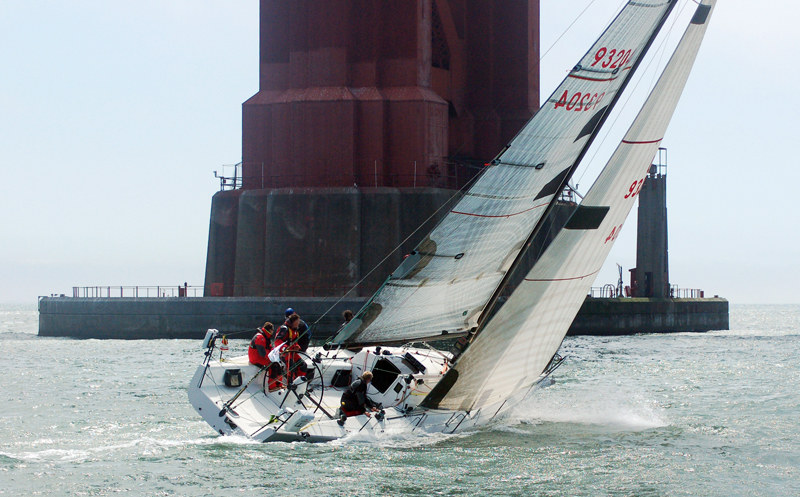
©2012 Latitude 38 Media, LLC
After a very slow start amidst an entirely confused weather pattern, the Pacific Cup Class of 2012 are now experiencing traditional racing conditions as they head toward Kaneohe Yacht Club on the island of Oahu’s lush windward side. The northerly "great circle" course appears once again to be the preferred route, and racers are encountering steady, strong winds in the high teens, though with few of the squall-like disturbances that they will encounter in the trade winds.
Wednesday 8:00 a.m. PDT (real time) standings show a few expected positions and a few reversals. Double Trouble, Andy Costello’s J/125, continues to lead the fleet and his division. With just 617.5 miles to finish, they’re nicely situated on the rhumb line in a 13-knot breeze at 220 degrees. Right there with them is Icon, the Perry 66 skippered by Kevin Walsh, with 617.9 miles to finish.
Moonshine, the Dogpatch 26, and Jamani, a J/120, keep trading off the lead in Double Handed 2, with Jamani currently leading. In Division A, Nick Salvador’s Baltic 37 No Strings Attached has slipped to third, with Kit Wiegman’s Islander 36 Cassiopeia zooming to first – it will be interesting to see if she can hold that spot with a jury-rigged boom attachment. Committee boat Valis, a Pacific Seacrft 44, has moved to second in Div A.
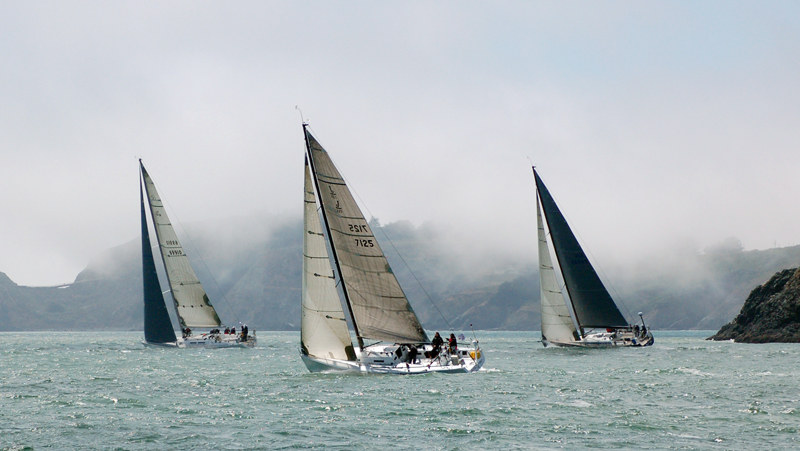
©2012 Latitude 38 Media, LLC
A few boats have reported damage, such as Cassiopeia, with a broken gooseneck, but are carrying on. Others have had more system-wide issues, mostly electrical, and have withdrawn, either to motor-sail to Oahu (Ciao Bella, Tayana V460 skippered by David Zarling), or return to the mainland (Juanita, Phoenix 38 skippered by Mike Stanton, and the doublehander Espiritu Santo skippered by John Silverwood).
For those that remain on the course, the careful calculus continues: go full out for speed and risk damage, or go cautiously, sacrificing a fraction of a knot and possibly a place on the podium.
One night of spectacular stars has been granted to the sailors in this moonless year. The rest of the race has been under cloudy skies, depressing unless you are sailing to Hawaii. That being said, Skip McCormack, navigator on Double Trouble, reported that it’s the first in nine Hawaii races where he’s been able to ditch the fleece early on, as it’s been warm. Nice.
From Valis, Michael Moradzadeh reports that at the 5:00 p.m. “Children’s Hour,” the fleet has entertained itself nicely with standings reports, technical discussions, and diversions such as a limerick contest and a new feature called, "You might be an offshore racer if…" A favorite response from the Olson 40 Buena Vista: "If your friends all grow glowing third eyes at night." Follow racer blogs and current standings at www.pacificcup.org.
Plastic Classic Initiation
Latitude 38 ‘ad guy’ Mike Zwiebach relates the tale of how he got involved with the first Plastic Classic race:
"I moved to the San Francisco Bay Area in the spring of 1985 and went to work in a friend’s family’s Zodiac store in Oakland. My boating experience up to this point was in canoes and kayaks on rivers. I quickly joined the Bay Area sailing community, and started racing every weekend and sailing at any available opportunity, or would just go mess about in one of our rigged Zodiacs.
"San Francisco Bay can be an intimidating place to learn about and participate in sailing. Even though I quickly felt comfortable as crew, I did not have much experience running my own boat.
"In the summer of 1986, I was tasked with a unique opportunity — to take our 18-ft Zodiac with a 65-hp outboard to assist with a new race, the Plastic Classic! I was a little less than prepared to head across the Bay to San Francisco from the sheltered waters of the Oakland Estuary and locate the Bay View Boat Club, but I was assigned the duty by my boss and was ready to go. Then I learned that my main mission was to pick up the original ‘Plastic Classic’, Carol Doda, and transport her from The Ramp restaurant’s dock out to the committee boat so she could start the race.
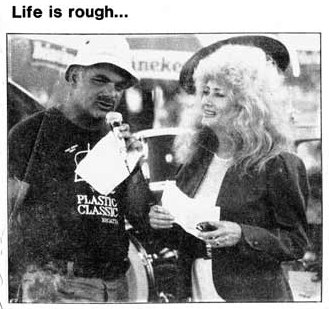
©2015 Latitude 38 Media, LLC
"This was the best first voyage of a sailor’s life! I can’t even say that I remember her or the day that vividly, as I was preoccupied with my role as skipper of the Zodiac and the excitement of the inaugural race. My clearest memories are of completing my duties, enjoying the day and the people, and returning safely back to Oakland with our company boat in good shape. What a great start to my boating life."
The Plastic Classic is still going strong – we’ll have coverage of the 28th edition in August’s Latitude 38. Carol Doda has since retired from her career as an exotic dancer and now runs a lingerie shop in San Francisco.
Boat Rides and Barbecue
The Cass Gidley Marina-Sausalito Community Boating Center will hold a free public event on the fourth Thursday of every month in an effort to raise funds (via donations) for the restoration of the facility as well as for various sailing programs. The first such fundraiser will be tomorrow at the beach in Sausalito’s Dunphy Park, 4:30-6:30 p.m. and will feature music by the Waterfront Pickers.
Enjoy free boat rides, drool over stunning locally handcrafted wooden boats, and tuck into some free BBQ. For more info, go to http://cassgidley.org/bb.
A Little Fact Checking Seems in Order
We rarely stray beyond sailing at Latitude, but today we lost our path thanks to a sometimes unintentionally funny and sometimes factually inaccurate story in the New York Times. The story is about 48-year-old Wave Vidmar, who apparently is soon to depart Horseshoe Cove in Sausalito for 2,200-mile distant Hawaii aboard a double-ended kayak.
In the first sentence, the Times wrote that if Vidmar succeeds, it will be the longest voyage of its kind. And later in the article, a member of Vidmar’s staff tells the Times, "The expedition will redefine what can be achieved with solo open ocean travel."
These claims are kind of funny because in the very same article the Times reports that in ’67, Edward Gillet kayaked from Monterey to Hawaii, arriving 63 days — and 25 lbs — later. So how can Vidmar’s proposed trip to Hawaii really be any longer than Gillet’s? And how could Vidmar possibly "redefine" what’s already been done?
Had the Times done a little research, they would have also discovered that back in ’51, Dr. Hannes Lindemann kayaked across the Atlantic in a Klepper inflatable kayak, using a model which is still in production today. But that’s nothing compared to the accomplishments of Oskar Speck. Over a course of seven years in the ’30s, Speck used a foldable kayak to make it all the way from Germany to Australia. If anybody is going to "redefine open ocean solo travel," they are going to have to deal with Speck’s legacy.
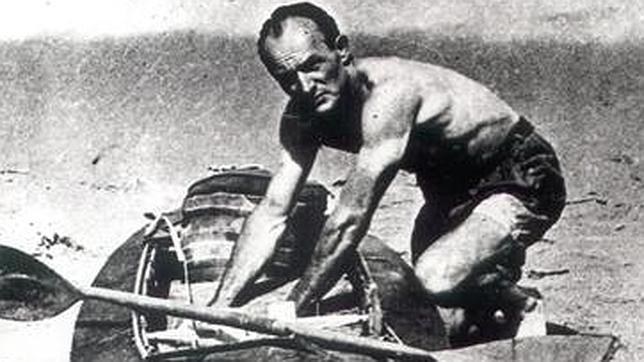
We don’t want to rain on Vidmar’s planned parade — after all, he has 100 times the courage we have — but we would like to provide some context to what he is planning to do. First of all, did you know that more than 300 people have rowed across the Atlantic Ocean? And that one man ‘swam’ across, sleeping at night in his little boat? And that another fellow — obviously French — drifted across the Atlantic on a mooring ball? And that it’s farther across the Atlantic than it is from San Francisco to Hawaii.
Indeed, drifting is the main moving force for many of these small boat ocean accomplishments. Lindemann, for instance, went with the wind and current across the Atlantic. Dr. Alain Bombard did the same, when he took off to prove his inflatables were seaworthy. But we’ll give Bombard bonus points, because he set off with nothing more than a sextant and very little food.
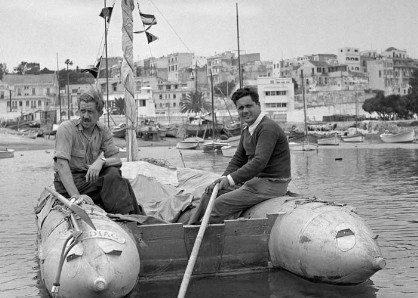
Indeed, one wonder of Gillet’s 63-day ‘paddle’ to Hawaii is that it took so very long. Our old friend George Sigler who, as the owner of the long-gone Survival & Safety in Alameda, founded the Singlehanded TransPac, once drifted from San Francisco to within 60 miles of Hawaii in just 56 days on a big sloppy raft. And that included getting rolled the first night and losing virtually all of his and his partner’s supplies.
If a kayaker wants to impress us as having paddled — as opposed to drifted across the Pacific — s/he will have to do it from Hawaii to San Francisco.
Three other phony factual claims in the Times had us scratching our heads: 1) That Vidmar could face seas up to 45 feet high. Right. Although we suppose that could be true if he paddled to the North Shore of Oahu and joined the surfers waiting for the first big swell of winter to hit. 2) That if he needs to be rescued, it could take days for help to arrive. We suppose that would be true if his EPIRB broke and/or the AMVER rescue system suddenly failed. And, 3) the trip will be about 3,000 miles. Does Vidmar plan on going to Hawaii by way of Cabo San Lucas?
And now, back to sailing.
